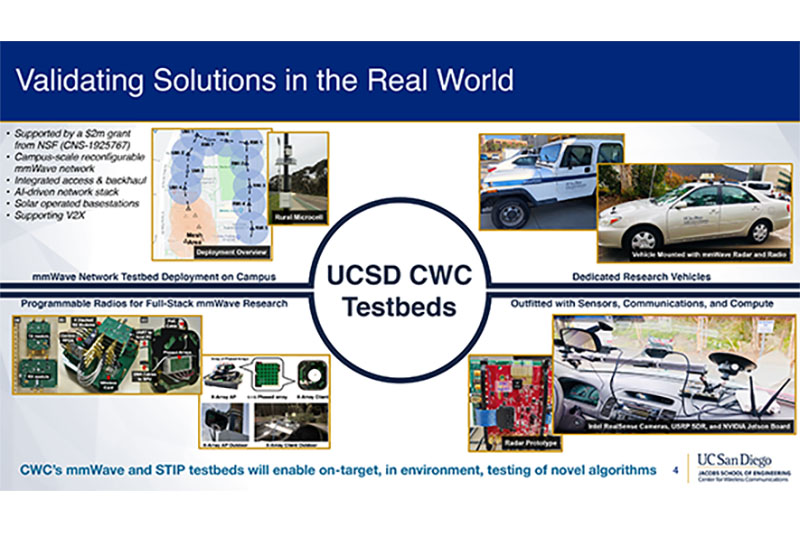Computing & Communications
Hybrid V2X Architecture and Testbed
Millimeter-wave (mmWave) radios are a key wireless technology that can enable multi-gigabit data rates. UCSD is deploying a campus-scale reconfigurable mmWave network that is solar operated and capable of integrated access and backhaul, a wireless technique that allows for cellular base stations (BS) to communicate with one another via the same wireless transmissions that they utilize for communications with cellular users. By including a renewable energy source and removing the need for a wired link to connect each BS to the internet, these cellular BS can be quickly deployed without the costly need to build new infrastructure to support them. Additionally, the team is investigating applications of Artificial Intelligence to provide more optimal control of the mmWave network that further increases energy efficiency, network capacity, and the coverage achievable by a single BS.
Architecture:
The STIP/CWC research team is developing a distributed computing and communication architecture, consisting of an overlapping network of road-side units (RSU) each containing a small cell (SC), a vehicular edge computing (VEC) node. Vehicles, street IoTs, and pedestrians in the coverage area of each RSU communicate with the RSU SC using hybrid V2X communication technologies. Each RSU is responsible for computing tasks for the road users and IoTs in its coverage area as appropriate. The VEC will be supplemented by any computing resources available in the associated vehicles (vehicular local computing (VLC) nodes), allowing the proposed tasks to be performed between the VLCs and VECs, helping satisfy the low latency, high computation and bandwidth requirements of the tasks.
Testbed:
We are developing an experimental testbed to explore hybrid vehicular-to-everything (V2X) communication and computing systems. The testbed consists of 3 small-cell base stations, deployed on rooftops on campus and connected to a core-network server. Two experimental vehicles are instrumented with hybrid wireless communication technologies including 4G/5G radios e.g., USRP B210, N310 etc., mmWave radios and also WiFi radios mounted on the top rack of the car or inside. The vehicles are also equipped with multiple sensors, e.g., multi-stereo cameras with depth sensors, multiple radars, in-vehicle camera, GPS IMU etc. To support the data acquisition from the vehicular sensors and any local computations, Vehicular Local Computing (VLC) units are placed inside the vehicles. The VLC units also run the protocol stack for the communication technologies. Each base station also comprises of multiple software radios to support the hybrid communication technologies and VEC nodes for computation fusion tasks. The software radios are programmable from physical layer signal processing all the way up to mobile application layer, thus enabling full-stack experimental research in V2X communication. Integrating programmable core-network stack as well as the radio hardware, the testbed will allow researchers to investigate prominent 5G features (e.g., low-latency networking, directional millimeter-wave communication, software-defined mobile networking, integrated access and backhaul) well before their deployment, especially for V2X use cases.

